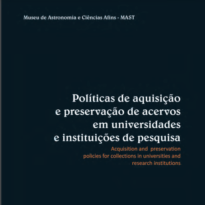-
O diagnóstico de acervos como subsídio para a política de aquisição: a constituição do acervo do Museu de Saúde Pública Emílio Ribas
- Voltar
Metadados
Miniatura

Título
O diagnóstico de acervos como subsídio para a política de aquisição: a constituição do acervo do Museu de Saúde Pública Emílio Ribas
Relacionado à Obra
Organizador(es)
OLIVEIRA, Lúcia Maria Velloso de | SILVA, Maria Celina Soares de Mello e
ISSN ou ISBN
978-85-6006-938-5
ISBN
978-85-6006-938-5
Sessão
TEMA 1 - A formação dos acervos científicos: a aquisição como estratégia de produção e preservação da memória científica
Páginas
81-97
Ano
Categoria
Local
Outro Idioma
Title/Título/Titre
The archive’s diagnosis as subsidy to an acquisition policy - the Museu de Saúde Pública Emílio Ribas archive’s construction
Abstract/Résumé/Resumen
The Museum of Public Health Emílio Ribas (Musper) of the Butantan Institute was created in the year of 1965 for the Secretaria de Estado da Saúde de São Paulo (SES) with the objective of reference the memory of the doctor Emílio Marcondes Ribas. Throughout the years it had its extended activities, including the preservation and diffusion of the history of the São Paulo public health. Since 2010 it is tied with the Butantan Institute when it starts to integrate the activities. This work is an integrating part of the first stage of the diagnosis that is being developed at the Museum. The objective it is to do a survey of the institutional history and the process of formation of its archive, identifying how much this trajectory influenced in it formation, constitution and identification. This way, we tried to detect what were the acquisitions politics adopted, contextualizing the archive and its importance for the memory of public health in São Paulo, to establish criterion for making available the construction of a new policy, suiting with the museum’s new project. The first step of the diagnosis is based on surveying the documents that represent the documents entrance, also interviews with old directors and profissionals who worked in the archives constitucion and idenfitication. As result we identify that the main nucleus of the archive was formed from the works of the Comissão dos 100 anos de Saúde Pública Paulista, in 1984, and after this period the entrance flow was reduced. We perceive that the archive of the museum was formed in the diverse agencies of the SES without any guard criteria established by the State, once the record management process is unfinished.




